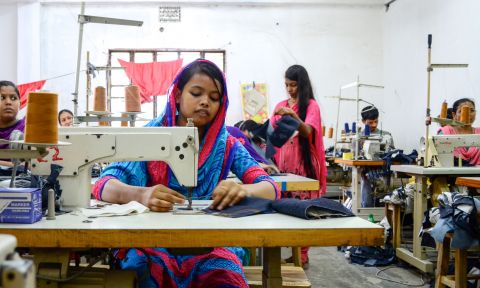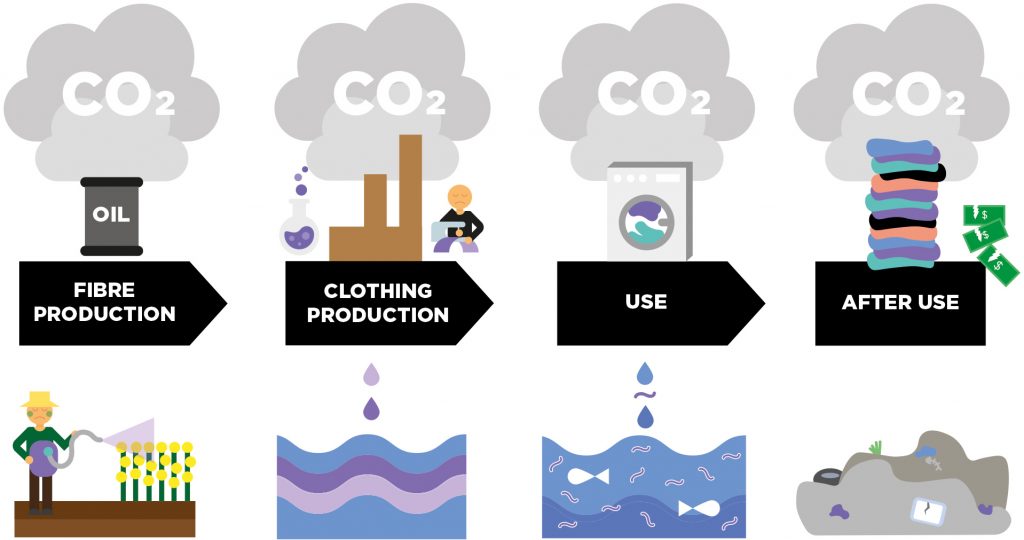(This post may contain affiliate links, meaning that if you make a purchase through a link, I might get a small commission from that purchase, at no additional cost to you. This keeps my blog running!)
Do you ever wonder how such cute clothes can be SO cheap!? The most in trend pieces and styles for ridiculously cheap prices is JUST what it seems- too good to be true! This is the fast fashion industry.
Today I wanted to talk about why fast fashion is bad and why you should stop supporting fast fashion. Hopefully, this article will teach you about the fundamentals of fast fashion, which rely on worker exploitation, environmental degradation, and consumer vulnerability in order to accumulate profit.

What is Fast Fashion?
From a business side, fast fashion implies the streamlining of production to get the cheapest clothes to racks at the quickest rates. This guarantees that people will keep coming and buying the latest looks, as they will be gone and replaced by new looks in quick time.
From a marketing and sales side, fast fashion implies the launching of new and trendy apparel being created and put on the racks every week.
In this process, clothes are hurriedly made in large volumes, resulting in the terrible quality these brands are notorious for having.
The clothes that they make are MADE to buy for cheap, wear a few times, then throw away! But this cycle has dangerous implications for workers and the environment.
Affect of Fast Fashion on Laborers
The already poor working conditions of textile workers in developing countries is only exacerbated by the emergence of the fast fashion phenomenon.
Fast fashion has uniquely affected laborers in sheer terms of production expectations. As mentioned above, fast fashion necessarily entails LARGE volumes of apparel that are available for a little while, before getting replaced with another large batch of something else.
This entails stricter deadlines for garment workers, longer work hours, unsafe working conditions, and potential for abuse.
There is no shortage of stories about the mistreatment and abuse of garment workers in the fast fashion industry.
Labor trafficking is rife in this industry due to the outsourcing and poor working conditions that most fast fashion companies are complicit in.
The International Labor Organization estimates that there are 170 million children engaged in child labor (a form of trafficking), and that a large portion of these children work in the textile industry (International Labor Organization).

Heartbreaking events like the collapse of the Rana Plaza factory and the resulting deaths of over 1,000 garment workers have in recent years brought to light some of the injustices that garment workers often face due to fast fashion brands outsourcing work to factories abroad… but NO ONE should have to die for fashion!
Affect of Fast Fashion on the Environment
Fast fashion is harmful to not only people, but also the planet.
The fashion value cycle consists of a chain of stages, including: raw material extraction, yarn preparation, fabric preparation, wet processes and finishing, garment production, transport, retail, product use, and end use. These stages can best be synthesized into three overarching stages: production, consumption, and disposal.

Each stage comes with unique sources of emissions and pollution, as shown in the above infographic.
Fast fashion repeats these stages on a linear level, meaning that the last stage of the cycle (end/after use) for any given fast fashion item necessitates the “death” of that item that contributes to our global waste problem. This linear economic model is best described as beginning with the extraction of raw resources and ending with these raw resources+energy it takes to process them ending up in landfills. Read more about the linear economic system here.
The Production Problem
Fast fashion is revolved around the constant churning out of new designs that travel from the runway to store racks in record time.
The industry is ahead and on top of all the latest trends and realizes the power in producing temporarily trendy clothing that isn’t durable.
As a result, clothing production doubled from 2000 to 2014.
The boom in production is powered by a greater energy demand. Energy is needed in order to power factories and machinery. It follows, then, that the energy and electricity usage of textile mills and clothing production operations is increasing rapidly.
Environmental Footprint of a T-Shirt
This is an environmental problem because the production of clothing is extremely energy intensive.
An average cotton t-shirt takes around 2,700 Liters of water to produce. This is enough water to satisfy a person for 900 days (World Wildlife Fund).
An embedded carbon analysis, which tracks the emissions created throughout the production of a product, reveals that it takes around 8.771 kg of Carbon Dioxide to produce a cotton t-shirt (Wang et. al, 2015).
This is about the same amount of Carbon Dioxide that would be emitted from driving 21.5 miles in an average vehicle.
Consumption of Fast Fashion
The production problem of fast fashion feeds into the consumption problem with fast fashion. Consumption of clothing has been rapidly increasing due to decreasing prices (and quality) that fast fashion offers. Between 2000 and 2014, there was a 60% increase in the average number of garments purchased per capita.
And just as the production problem feeds into the consumption problem, so too does the consumption problem feed into the waste problem- the final stage of a garment’s life in the system of fast fashion.
Waste from the Fashion Industry
As we talked about, these cheaply made clothes have a short lifespan. Quick to damage, fast fashion items often end up going straight to the landfill after being deemed “un-sellable” by consignment and thrift stores.
Turns out that in 2012, 84% of unwanted clothes in the U.S. ended up in an incinerator or a landfill... that’s over 10 MILLION tonnes of clothes to dumps per year! This is only going to increase due to the growing pervasiveness of fast fashion.
What if your clothing donations are accepted by a consignment store? Well, the average secondhand shop gets WAY more donations than purchases (due to fast fashion, nonetheless)…. and can sell only ~20% of what is donated.
The rest of what is donated? Well, most of the excess clothing is shipped off to Africa. The U.S. exports over a billion pounds of used clothing every year, sold to Sub-Saharan and East African countries.
SO that’s good, right?
Not necessarily. This constant inundation of used and unwanted/damaged clothes (exacerbated by growth of fast fashion), eliminates jobs in Africa for clothing manufacturing, design, and production.
The importation of used and unwanted clothing to African countries has created a controversial dependency model in which countries depend on passed down goods.
In 2015, countries part of the East African Community (EAC), announced a plan to ban imports of second hand apparel from America.
Why? Because western clothing exports have eliminated the growth of industry for many developing nations in Africa.
Take Kenya, for example.
Kenya had a booming textile industry until the 1980s, before a World Bank promoting second hand exports went underway. From the 80s to now, the number of Kenyans employed in the textile industry has fallen by more than 96%.
This cycle has created a new sort of jobs in which people collect imports and then sell them in a marketplace, but these jobs are replacing potential ones that would be much more profitable for workers AND the countries at large.
Leading Fast Fashion Brands
- Zara
- Romwe
- Shein
- H&M
- Forever 21
So.. What Can You Do?
- When you buy, shop from HIGH QUALITY brands that are transparent about their manufacturing process and labor standards.
- Start thrifting! Engaging in thrifting is not only FUN, but it also helps contribute to the circular economic model that the fashion industry so desperately needs.
- Take care of your clothes! This extends the shelf life of clothing, keeps your closet unique, and prevents more waste from piling up in landfill.

Thanks for reading friends, I know it was a long one! I hope this information was helpful and will lead you on your journey to a more sustainable lifestyle.
For more articles on how to reduce your environmental footprint, check these out:


Pingback: Is Thrifting Ethical? On Conscious Thrifting… |
Pingback: Human Trafficking 101 |